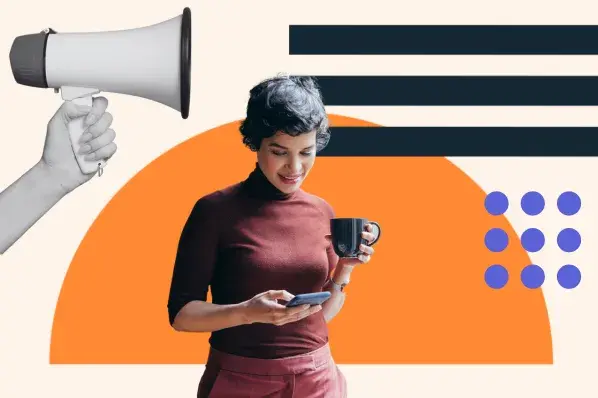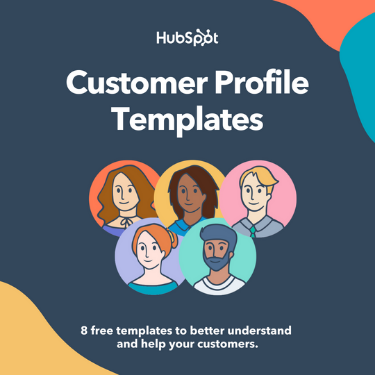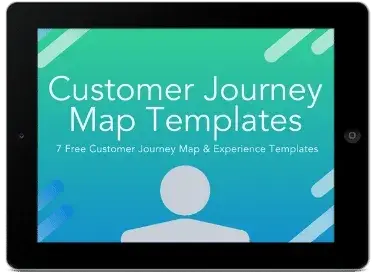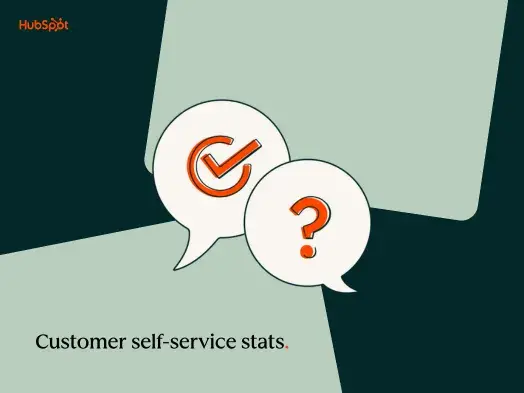The first step toward creating customer experiences that result in happy, loyal customers is understanding and meeting customer needs.
In this article, I’ll delve into the different types of customer needs, how to identify them, and even how to leverage AI to enhance your approach.
Table of Contents
- What Are Customer Needs?
- How to Identify Customer Needs
- What Is a Customer Needs Analysis?
- Best Channels to Meet Customer Needs
- What Customers Want
- Why Are Customer Needs Important?
- Utilizing AI to Understand Customer Needs
- 18 Most Common Types of Customer Needs
- How to Solve for Customer Needs
- What Do Customers Want From a Typical Customer Service Situation?
What Are Customer Needs?
A customer need is a motive that prompts a customer to buy a product or service. Ultimately, this need drives the customer's purchase decision. Companies often view customer needs as opportunities to resolve or contribute surplus value back to the original motive.
A prime example of a customer need happens every day around noon. When lunchtime rolls around, I’m usually hungry and need to eat. The desire to satisfy hunger is a basic human need as well as a customer need that influences a purchasing decision. The problem (need) is hunger, and the solution is food. I’ll buy lunch from a restaurant or make something for myself at home to satisfy this need. In either circumstance, I’ve turned to a company that offers a solution to fulfill my needs.
Customer-centric companies understand that solving customer needs and exceeding expectations drives healthy business growth and fosters strong relationships with the people they serve.
It’s easier said than done, but it all starts with identifying your customer needs and crafting your products and strategy to solve them. Not all customer needs are as straightforward as hunger, but if you listen to your customers, they will tell you about the solutions they desire.
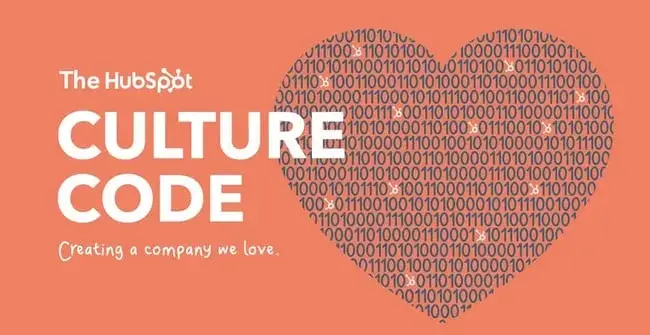
Why Are Customer Needs Important?
In my past experience as a HubSpotter and my present experience as a business owner, I’ve come to realize that obsessing over customer needs is crucial for several reasons:
Business Growth
Anticipating and solving customer needs is essential for continued business growth. I’m always trying to put myself in the customer’s shoes to understand how I can better serve them.
Customers who have their needs fulfilled are satisfied customers, and they will help sustain your business in several ways:
- Increases customer retention. Satisfied customers are more likely to return to your company and make repeat purchases. Acquiring new customers is five times more expensive than retaining existing ones, so maximizing retention is a serious cost-saving measure to help sustain profitability.
- Drives positive word-of-mouth. 86% of loyal customers will recommend the brand to friends and family, which expands your brand’s reach.
- Increases customer lifetime value. Meeting customer needs can lead to increased CLTV as you’ll retain customers and increase revenue over time.
Enhanced Customer Satisfaction
I’ve also found that meeting customers' needs — and even going above and beyond — has a direct correlation with higher levels of customer satisfaction. That’s probably not too surprising, but here are some added benefits:
- Builds trust and loyalty. Customers will feel understood and valued when you empathize with their issues and put genuine effort into solving their needs. These loyal customers will be the backbone of your business, bringing in consistent revenue throughout their lifetime with your company.
- Reduces churn. Consistently solving customer needs means fewer customers will leave your business in favor of competitors.
Driving Innovation
A business that is consistently focused on solving customer needs never has to worry about falling behind. The customer and their needs dictate which products and services are successful and will reveal how you can improve and develop new offerings to stay competitive.
- Identifies market gaps. Staying in touch with customer needs can help reveal areas where their needs are unmet. Those are your opportunities to fill gaps in the market and offer products and services that customers are delighted to pay for.
- Helps you stay competitive. Continuously adapting to customer needs keeps your business relevant. If customers always find your product/service useful, you’ll never go out of style.
Anticipating customer needs means giving customers what they need before they realize they need it. This will increase customer satisfaction and reduce the load on your customer service teams.
Companies that proactively solve customer needs are more likely to experience growth, innovation, and retention. Creating a customer-centric company that truly listens to customer needs can be challenging, but I’m here to help.
Utilizing AI to Understand Customer Needs
Leveraging AI can significantly enhance your ability to identify and understand customer needs. However, the human element of meeting customer needs is still more important than ever.
AI tools can streamline processes and make sense of vast amounts of data, but these tools are nothing without teams of real humans who are empathetic and dedicated to solving customer needs.
Here are some ways AI can help you identify customer needs:
Data Analysis at Scale
AI algorithms can process vast amounts of customer data and identify behavioral trends and preferences humans may have previously missed. Traditional methods of gathering customer data, such as surveys and focus groups, although still valuable, are limited in scope and take time to collect. AI can help you harness the power of big data and real-time analytics to make sense of customer needs in a previously unattainable way.
Predictive Analytics
By analyzing historical customer data, AI can predict future customer actions and needs, allowing businesses to meet those needs proactively. AI-powered systems can reveal patterns and trends that enable you to anticipate customer needs and tailor your offerings before customers are fully aware of their emerging needs.
Sentiment Analysis
AI-powered sentiment analysis tools can process vast amounts of customer reviews, comments, and feedback from various sources. Using Natural Language Processing (NLP), AI tools can distill all that information into a nuanced understanding of how customers feel about your brand and their needs.
The intersection of AI and customer needs is a fascinating place to explore. Businesses today can gain deeper insights than ever by utilizing AI to make sense of patterns and analyze datasets that were previously too vast, complex, or seemingly unrelated to understand. However, it is crucial to recognize that the human element of customer service and fulfilling customer needs is more important than ever. AI isn’t a replacement for a personal touch, and in fact, it can often miss out on the more nuanced aspects of human communication, such as sarcasm.
So, AI is a handy tool for solving customer needs, but remember what it is: a tool. AI can support your customer needs journey, but don’t let it replace the human empathy that is the cornerstone of customer centricity.
18 Most Common Types of Customer Needs
Customer needs can be split into two categories: product and service.
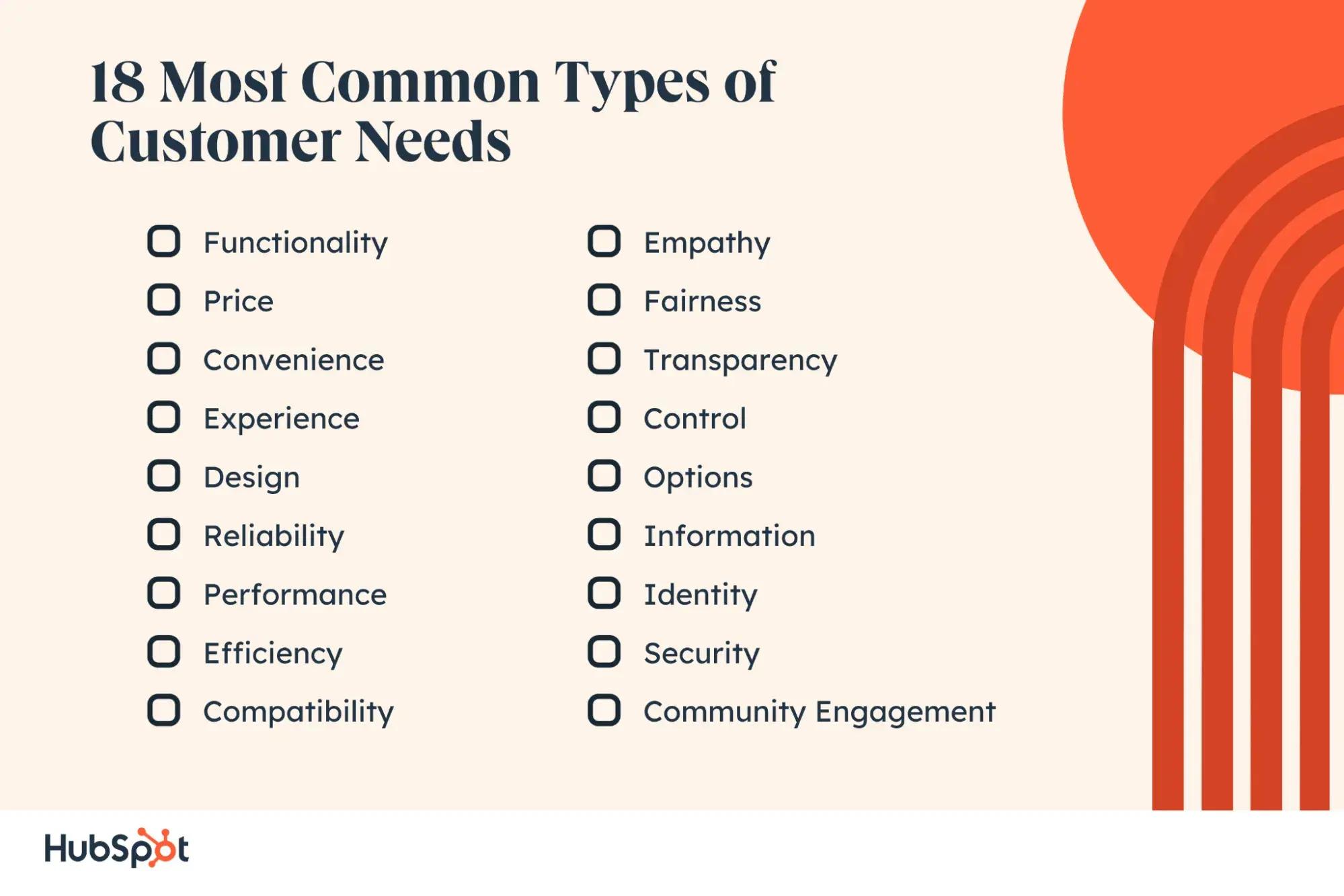
Product Needs
1. Functionality
Customers need your product or service to function correctly to solve their problems or meet their desires.
Example: When musicians rent gear from my backline business, they expect it to work. When I got my first rental request for a guitar amplifier for a local festival, I was excited but nervous. The amp needed to work flawlessly for the sake of the performance and my reputation. That’s why I triple-check each piece of gear to ensure it is functional before sending it out.
2. Price
Customers have unique budgets and price points that they can afford. Certain brands may fulfill customers' needs on a tight budget. In contrast, others may cater to consumers who specifically desire a high price point to satisfy psychological needs of status and prestige.
Example: As a touring band, we have a tight budget, especially regarding life on the road. Accordingly, we often spend the night at Best Western or other budget-friendly hotels (and cram eight guys in two rooms) to help us save money.
3. Convenience
Your product or service needs to be a convenient solution to the function your customers are trying to meet. That means your product is easy to assess, simple to use, or generally saves the customer time.
Example: Musicians on the road often have a lot going on between load-in, soundcheck, press obligations, and trying to find something decently healthy to eat. I offer delivery and setup services in my backline business to make it as convenient as possible for my customers on the day of a show.
4. Experience
One of the most basic yet powerful customer needs is a memorable and positive experience using your product. That can mean that your product is easy to use or just leaves them feeling happy having engaged with you.
Example: The fans who come to my band’s shows seek an experience. They want to feel happy, free, and connected with the music, us, and the people around them. We do everything we can to create a memorable show, including personally greeting and interacting with fans after the show.
5. Design
Many customers are design-oriented and need products that fit their aesthetics and preferences to be fully satisfied. I’m one of those customers. Even products as simple as a phone charger need a design-forward vibe for me to pull the trigger, regardless of functionality.
Example: Selling merchandise (t-shirts, hoodies, hats, etc) is a massive part of the business for touring bands. We offer design-forward merchandise that fits the needs of fashion-forward customers. That way, people who aren’t even fans of the band will want to buy our merchandise just because they like the designs.
6. Reliability
The product or service needs to perform consistently every time. You might have the most potent product in the world, but it’s worth nothing if your customers can’t rely on it to work all the time.
Example: My backline rental business customers expect reliability from me and all the gear I offer. The last thing anyone wants is an amp to blow up or a keyboard stand to collapse mid-performance. To ensure reliability, I thoroughly inspect and test every piece of gear before I send it out and as soon as I get it back in the shop.
7. Performance
The product or service needs to perform correctly so the customer can achieve their goals. However, the required level of performance can vary and is sometimes a function of budgetary needs.
Example: I just moved into a new apartment and needed a vacuum. Since I live in a relatively small space with wood floors, I didn’t need an ultra-high-performance vacuum. I bought a stick-style apartment vacuum, which works perfectly for my needs. Of course, it doesn’t have the same insane level of suction as a shop vacuum, but I don’t need that level of performance.
8. Efficiency
Customers value products or services that streamline processes and save time. Time is money, and efficiency is becoming paramount in all aspects of customers' lives.
Example: I use the HubSpot Sales Extension in my Gmail inbox to track and log emails for my backline rental business. It allows seamless integration with HubSpot CRM and saves me a lot of time during sales outreach and customer correspondence.
9. Compatibility
The product or service must be compatible with your customer's existing products.
Example: I use Splice to source samples and sounds for music production. There are plenty of places online to find drum sounds and vocal chops, but I chose Splice because it is compatible with Logic Pro X, the music production software I use.
Service Needs
10. Empathy
When customers contact customer service, they want empathy and understanding from the people assisting them. Empathy involves active listening and a genuine, compassionate understanding of the customer’s needs and pain points.
Example: I was a member of HubSpot’s support team right out of college, and empathy was always at the top of my mind for the entire department and me. I made sure to greet customers kindly and express a genuine concern for their issues. In my experience, customers appreciated that we genuinely cared about helping them out, not just closing their tickets as quickly as possible.
Are you looking for customer-centric email templates to help out your reps? Look no further: 50 Customer Service Email Templates.
11. Fairness
Customers expect fairness from a company in terms of pricing, terms of service, contract length, and more. No customer wants to feel like they are being taken advantage of. Embodying fairness in your strategies and products will cultivate strong and trustworthy customer relationships.
Example: I recently had an issue with my bass amp from the Finnish company Darkglass Electronics. I bought the amp secondhand, so they could easily have told me I was out of luck in terms of warranty. However, their customer support team was empathetic and offered multiple solutions to help me fix the amp.
12. Transparency
Customers expect transparency from a company they're doing business with. Service outages, pricing changes, and things breaking happen, and customers deserve openness from the businesses they give money to.
Example: Sometimes things break when you work with software. At HubSpot Support, I was always transparent with customers regarding service outages or product issues, and they appreciated me keeping them in the know.
13. Control
Customers need to feel like they‘re in control of the business interaction from start to finish. Customer empowerment shouldn’t end with the sale. Make it easy for them to return products, change subscriptions, adjust terms, etc.
Example: I love Costco, and not just for the $1.50 hotdog and drink combo. Costco offers a robust return and customer satisfaction policy, so I have complete confidence in any purchase I make there. I know that I always have the option to return a product for any reason, and that elevated level of control makes me feel secure about my relationship with them as a customer.
14. Options
When customers are ready to purchase from a company, they need options. To provide that freedom of choice, offer a variety of products, subscriptions, services, and payment options.
Example: As a customer, I expect to be able to contact support in every way possible, including phone, email, live chat, and social media. Offering an omnichannel support experience is vital in today’s landscape, where customers have an elevated ability to choose.
15. Information
Customers need information from the moment they start interacting with your brand to days and months after making a purchase. Businesses should invest in educational blog content, instructional knowledge base content, and regular communication so customers have the information they need to use a product or service successfully.
Example: I offer detailed descriptions of all rental gear in my backline business. I also regularly update my blog with helpful information about popular rentals and how to choose the right gear for the gig. All of this additional information is especially helpful to newer customers who may not be musicians or are unfamiliar with the standard practices of setting up a show.
16. Identity
Customers want to align with brands that reflect their identity and values. Doing so fosters an emotional connection between your brand and the customer and makes them feel good about doing business with you.
Example: I care about sustainability and the environment, so I align myself with brands with the same values. For instance, I love Pukka tea for its sustainable packaging and carbon-neutral footprint, and the tea is great, too.
17. Security
Customers need to know they are in good hands when using your product or service. They need to know their safety is a priority both physically and in terms of their data and privacy.
Example: I live in New York City and only trust Kryptonite bike locks to keep my bike securely locked up on the street. Numerous customer testimonials and reviews fulfilled my need for security. Kryptonite locks were the only brand my fellow New Yorkers trusted, so now I feel secure using one to lock up my bike.
18. Community Engagement
Customers appreciate feeling part of a community centered around a brand they are about. It makes them feel fulfilled and excited to engage with your brand and other like-minded people, strengthening the relationships of all parties involved and bolstering your bottom line.
Example: We host fan meet-and-greets at the merch table at every one of my band’s shows. We also actively engage with fans on social media and allow fans to support our band as members of our Street Team, where they can promote our shows in their hometowns in exchange for free tickets and access to exclusive merch items.
With so many types of customer needs, how do you understand which ones apply specifically to your customers? Next, I’ll show you some strategies for identifying customer needs.
How to Identify Customer Needs
- Use existing data.
- Solicit customer feedback.
- Map the customer journey.
- Get input from service teams.
- Study competitors.
- Listen to social media.
- Conduct keyword research.
“You've got to start with the customer experience and work backwards to the technology,” Steve Jobs notably said. “You cannot start with the technology and try to figure out where you are going to sell it.”
I think this quote rings true no matter what type of product you are selling. It doesn’t matter if you are selling technology products or running a rental business. I’ve learned that understanding who your customers are, where they come from, and what they need is essential in offering them something of actual value.
Understanding customer needs requires more than just putting yourself in the customer’s shoes. I’ve outlined some strategies below to help you understand what your customers seek.
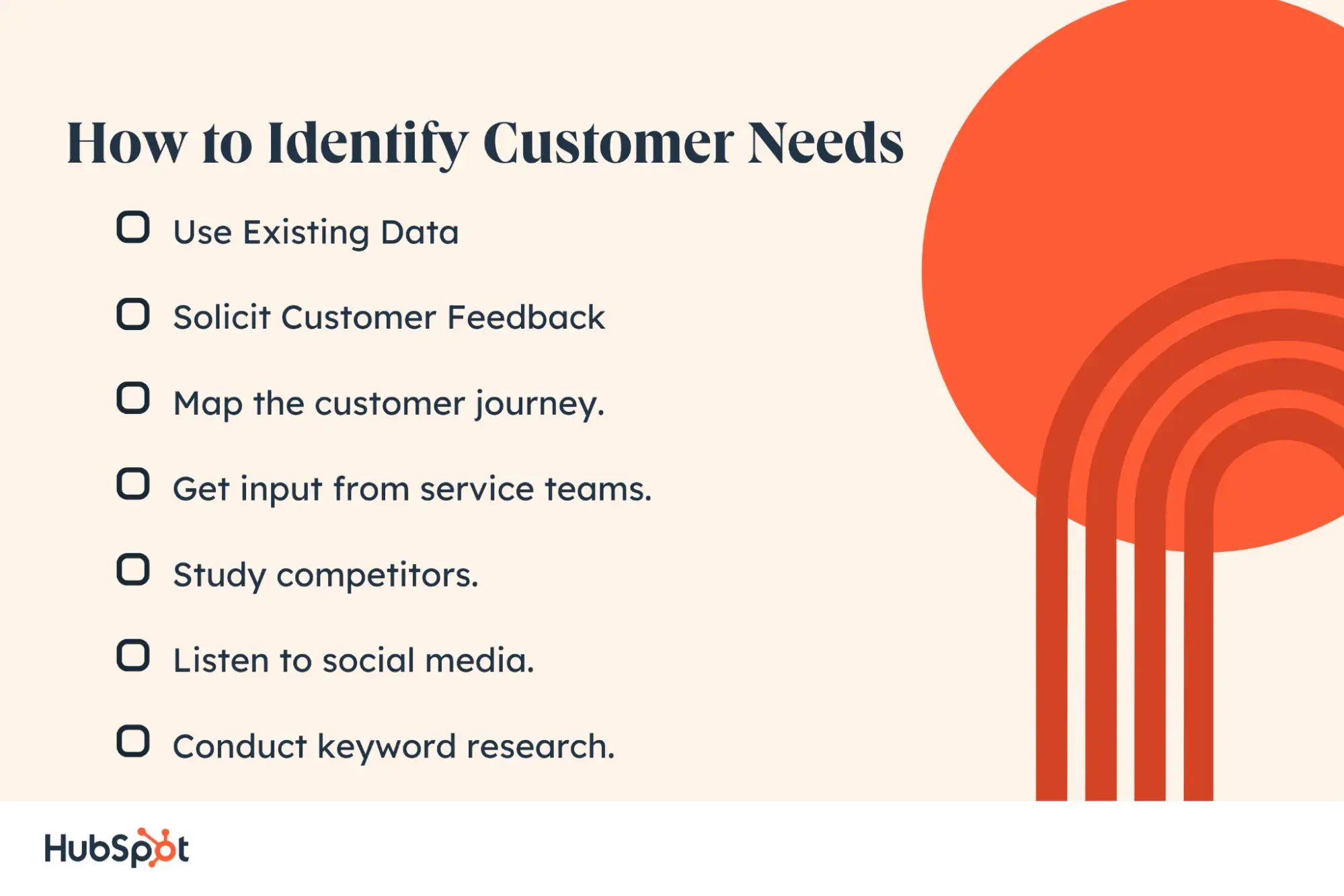
1. Use existing data.
Leverage your CRM and other analytics tools to understand what your customers are looking for and the issues they face along the way. For example, I use HubSpot CRM to manage my backline business. I closely monitor rental histories and requests to understand which equipment is most popular and what types of new gear I can invest in to meet customer needs.
You can use AI products like HubSpot’s Breeze to enrich the data in your CRM with AI intelligence and AI data-sourcing to identify buyer intent.
2. Solicit customer feedback.
Customer feedback allows you to identify customer needs right at the source. You can use surveys, focus groups, or interviews to gain an in-depth and firsthand understanding of your customers' needs. Using AI tools, you can extract more value from customer feedback with sentiment analysis to understand how your customers feel about your brand.
As a customer, I’m not usually eager to fill out every customer satisfaction email that finds its way into my inbox. So, I recommend incentivizing your customers to tell you more about their experience with discounts, freebies, or even an entry into a giveaway contest.
3. Map the customer journey.
Understanding where your customers are in their customer journey is critical to best assisting them. Customer journey mapping helps you visually represent the steps customers take when interacting with your brand. Mapping the customer journey will help you create a more proactive customer service approach, personalize outreach, and meet customers where they are with the products they need.
Featured Resource: Customer Journey Map Templates
4. Get input from service teams.
Your customer service teams are treasure troves of information on customer needs. As a former support representative at HubSpot, I can attest to it. As a frontline representative, I spent my whole day speaking with customers and helping them use our product. In doing so, I learned much about customer needs and pain points.
AI tools like customer service chatbots can further enrich the information you gather from your service teams. AI chatbots will help reduce the load on your teams, and you can use intelligence to analyze customer sentiment and pain points across thousands of service interactions.
Featured Resource: Customer Support Strategy & Planning Template
5. Study competitors.
Studying competitors is commonplace in market research, but it's also an invaluable practice for identifying customer needs. By analyzing competitors with a similar target audience to yours, you can gain insight into the types of needs they are solving on behalf of customers. You might even discover gaps in services, which represent unmet customer needs and a niche you can fill.
For example, when starting my backline rental company, I did extensive research and identified the most common pieces of gear that customers were looking for. However, as a bassist, I noticed that most rental companies lacked variety in bass-specific gear. So, I decided to fulfill that need for discerning bassists who wanted something more than the basic backline amp.
6. Listen to social media.
Your customers use a variety of social media platforms daily. Customers often take to social media to praise, complain, request new features, or talk about brands they engage with. You can use social media listening tools to track what people say about your brand, their comments on your posts, and more.
When I worked at HubSpot, I monitored the HubSpot Support Twitter to keep an ear to the ground on customer needs online and was able to help some customers whose needs likely would have gone unmet had we not been listening.
With the advent of AI tools, you can analyze customer messaging on social media at scale to infer their sentiment toward your brand and identify relevant trends that will inform your strategy for responding to customer needs.
7. Conduct keyword research.
In today’s digital age, practically every customer journey starts with a Google search. Uncovering the search terms your customers use to find your brand and similar brands online can reveal much about your customers' needs. Not only does performing keyword research help you understand customer needs, but you can also optimize your website for SEO by targeting the keywords your customers use most.
I performed extensive keyword research when setting up my backline rental business, and in doing so, I discovered a lot about my customers‘ needs. For example, most people weren’t just searching for “‘backline rental near me,” but instead, I discovered that customers’ needs were much more varied. Specifically, I was surprised by how many people needed to rent keyboard stands and drum thrones.
By designing your processes with the above strategies in mind, you can uncover customer needs at all lifecycle stages. To delve deeper into the specifics of customer needs, consider conducting a customer needs analysis, which will help you tailor your products and services to meet customer expectations more effectively.
What Is a Customer Needs Analysis?
A customer needs analysis is used in product development and branding to provide an in-depth analysis of the customer to ensure that the product or message offers the benefits, attributes, and features needed to provide the customer with value.
I follow these key steps when I set out to conduct a customer needs analysis:
1. Run a customer needs analysis survey.
Before you start analyzing customer needs, you need to gather information. I begin by running surveys to help determine my company’s position in the market and how we compare in meeting customer needs.
Surveys may include questions about:
- Our brand and competitors. These questions seek to understand customers' perceptions of our brand and their associations with it.
- Product awareness. To gauge how familiar customers are with our offerings.
- Brand attitudes. To learn about customer sentiment.
Here are some example questions that I might include:
- What are some words that you associate with our brand?
- What are some brands that you consider similar to ours?
- How would you rank these brands according to your preferences and needs?
You can learn more about conducting surveys in our Ultimate Guide to Brand Awareness.
2. Perform a means-end analysis.
After collecting survey responses, I would use a means-end analysis to understand what drives customers to purchase from us over competitors and what sets our services apart.
In a means-end analysis, there are three main drivers for why customers would choose our product over another:
1. Features: The specific attributes of a product or service.
- Example: A customer might rent a specific bass amp from me because it has high wattage and can provide enough sound for a big stage.
2. Benefits: Real or perceived advantages that the product offers.
- Example: A customer might rent a specific guitar amplifier from me because it has a clean, versatile sound, which is vital in festival scenarios when many guitarists share the same backline amplifier.
3. Values: Unique, individual values that a product helps the customer fulfill.
- Example: A customer might rent a 1970s drum kit from me because it has an old-school vibe that meshes with their band's vintage aesthetic.
Grouping customer motivations into these categories can help you identify the needs you consistently address and where you can put in extra effort.
3. Gather customer feedback.
The best way to understand customers' thoughts about your company is to ask them directly. You can send out email surveys post-purchase or do it the old-fashioned way and chat on the phone. Since my backline rental business is small, I do most of my business on the phone. I talk to my customers directly and learn about their experience renting from me.
In doing so, I focus on identifying:
- Points of friction. Were there any difficulties?
- Moments of delight. What exceeded their expectations?
Based on my conversations with customers, I ask myself questions like:
- What can I do to make the customer experience smoother?
- What do customers see as my strengths, which I can build upon?
- What do customers need that I don’t currently offer?
How to Solve for Customer Needs
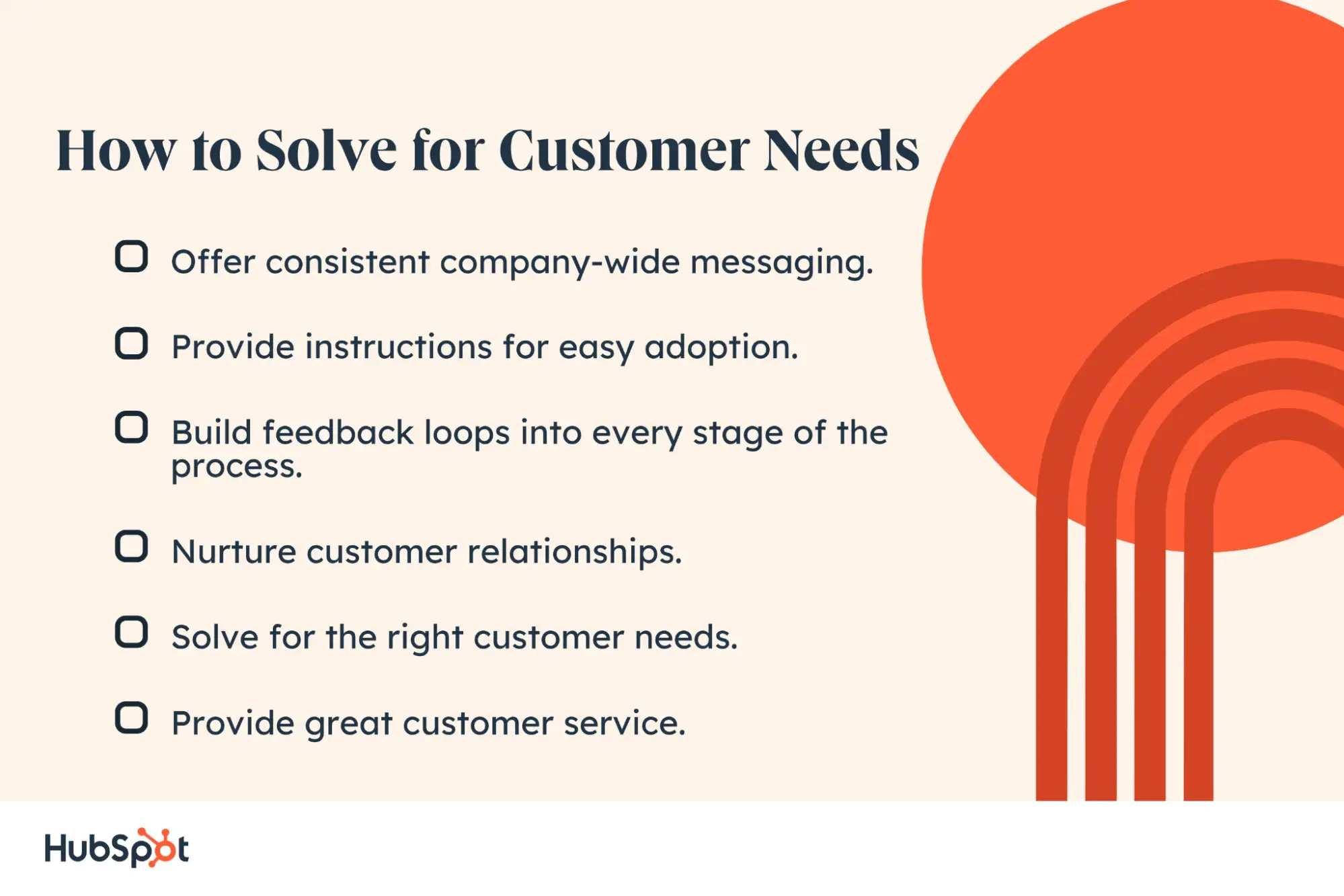
The first step to solving customer needs is to walk a mile in their shoes. If you were the customer, what would you need from the product or service to get the ultimate value for your money?
Here are some tips for distilling the customer information you’ve gleaned through customer needs analysis into action.
1. Offer consistent company-wide messaging.
The last thing you want to do is confuse your customers with inconsistent messaging about your product or what it does. Everybody needs to be on the same page to solve customer needs best. Unsurprisingly, the key to consistent messaging is consistent internal communication.
Here are strategies I recommend for consistent internal communication:
- Organize team meetings. In my band, we have weekly meetings to chat and discuss our vision for our upcoming album. Consistently discussing what we want from our next project allows us to align on goals, values, and preferences, hopefully translating to music our fans can connect with.
- Provide clear documentation. Create an internal knowledge base that is the single source of truth for company-wide policies and any common questions employees may have.
- Require employee training. Ensure new employees are effectively brought up to speed regarding your organization's culture and standard practices. When I worked at HubSpot Support, I went through an extensive training process, during which I became familiar with the product and the cultural climate of customer-centricity.
2. Provide instructions for easy adoption.
Customers purchase a product because they believe it will meet their needs and solve their problems. However, the adoption and setup stages are not always clear. You must set customers up for success with your product by ensuring they can access the resources they need to attain value as soon as possible.
A solid post-purchase strategy ensures customer needs are met throughout their lifecycle with your brand. Here are some strategies I recommend implementing so customers can get up and running with your product as soon as possible:
- In-product walkthroughs. Meet customers where they are with an in-product tutorial that shows them how to navigate and best use your product.
- Create email instructions. Create an automated email onboarding campaign to send customers helpful content and FAQs at specific points in their onboarding journey.
- Build a customer knowledge base. Maintain a searchable knowledge base with helpful resources for customers regarding any aspect of your product or service.
3. Build feedback loops into every stage of the process.
The best way to solve customer needs is to listen to what they have to say. Allow customers to provide feedback throughout the process of engaging with you and your product, especially at known bottlenecks or critical junctures.
Here are some strategies I recommend for incorporating feedback loops into your processes:
- Collect customer satisfaction scores. Survey your customers at specific junctures to gauge satisfaction. For example, I send a customer satisfaction survey to my clients a few days after their rental date to learn more about their experience.
- Conduct customer interviews. Having one-on-one conversations with clients will give you insights into customer needs that surveys may miss. Consider setting up monthly check-in calls with customers to manage and enable their success with your product.
- Monitor social media. Listen to what your customers are saying online. You can run polls and questionnaires or monitor what customers say about your brand to learn where you can improve. For example, we post pictures on Instagram after my band's shows, and I’ll closely monitor the comments to learn what the fans like and how we can improve the next show.
It is crucial to act on the feedback you collect. Take customer suggestions seriously and act on them whenever possible to improve your product or service offerings. I also recommend sharing poignant feedback internally so the organization knows the customers’ needs and can focus its efforts accordingly.
4. Nurture customer relationships.
Customer relationships are ongoing and certainly don’t end right after purchase. You must proactively build the customer relationship to ensure they don’t lose excitement and churn after onboarding.
Many companies maintain customer relationships through dedicated customer service and success teams who stay connected to long-term customer needs. Service teams improve customer retention via regular check-ins and even rewards/gifts for the most loyal customers.
Here are some ways I nurture relationships with my customers (the fans of my band):
- Show appreciation. Personally greet fans after shows and offer exclusive content, merch items, and early access tickets to our most loyal supporters.
- Host events. We sometimes host fan meetup events before shows to create a bond with our audience and foster a sense of community around our brand.
- Respond to feedback. I personally respond to Instagram comments and DMs from fans so they feel seen and connected to us.
5. Solve for the right customer needs.
As a recovering people-pleaser, one of the most challenging lessons I’ve learned in life is that not everyone will like you, and it's not a good use of time to try to make them. The same applies to business. You can’t be every customer’s cup of tea, so focus your energy on those customers whose needs you can best address.
- Create buyer personas. Creating buyer personas helps you define your ideal customers. Instead of trying to sell a product that everyone will love, focus on solving the specific needs of a certain group of people that aligns with your resources and vision.
- Focus on core competencies. Simply put, focus on your strengths. Solve the customer needs that you are particularly suited to handle. For example, I offer a lot of bass gear in my rental business since I have extensive experience as a bass player and can empathize with the needs of other bassists.
- Communicate clearly. Being upfront and setting expectations of the customer needs I can and cannot handle sets the customer and me up for success.
6. Provide great customer service.
Customer service is make or break. Even if you have the best, most effective product in the world, it means nothing if you can’t help customers when they need it most. Getting issues resolved efficiently and empathetically is a customer need in and of itself. Here are some of my recommendations for top-tier customer service:
- Offer omni-channel support. Meet your customers wherever they are and allow them to contact you however is most convenient for them. That means phone, email, live chat, and social media, at the very least. Your customers should have no doubts about how to get in touch with you.
- Listen with empathy. When I worked at HubSpot Support, I learned to listen attentively and validate the customer’s feelings before working toward a solution. This is especially important during challenging cases with upset customers. Putting yourself in the customer’s shoes is paramount for solving their needs.
- Solve issues quickly. This does wonders for customer satisfaction. Time is one of the most fundamental customer needs, so solve for it through proper training, staffing, and resources to ensure your reps can help customers to the best of their abilities.
Some customer needs are time-sensitive and require immediate interaction via phone or chat. Others are less critical and can be resolved at a more casual pace. Either way, you need to meet customers where they are to solve their needs best. Next, I’ll discuss the best channels to meet customer needs.
Best Channels to Meet Customer Needs
- Phone
- Chat
- Social Media
- In Person
- Call Back Service
- Customer Self-Service
- AI Chatbots
- Interactive Virtual Assistant
- Integrated Customer Service
1. Email
Many customers, including myself, prefer email as their support channel. I like email because it allows you to handle non-urgent requests in a simple, straightforward fashion. Using email, you can meet customer needs asynchronously.
Here are some pros and cons of email as a channel for meeting customer needs:
Pros
- Convenience: Customers can send you an email on their schedule.
- Documentation: Both you and the customer have a record of everything discussed in an email chain.
- Thoughtful responses: You have time to craft a thoughtful and detailed reply.
Cons
- Delayed response: Not recommended for urgent issues.
- Cluttered inboxes: Emails can be missed from time to time. Not if you use a ticketing system, though!
- Potential lack of clarity: Some issues can be complex and are best described over the phone.
2. Phone
Phone support offers an immediate, personalized channel for solving customer needs. I prefer phone support for customer needs that are urgent and require an empathetic human touch.
Pros
- Real-time interaction: Speaking on the phone with a real person means customers can get their needs met immediately.
- Personal touch: There’s no substitute for talking to a real person who genuinely wants to help.
- Effective for complex issues: Often, it is easier to explain complex issues over the phone than a protracted back and forth via email.
Cons
- Limited availability: Some businesses can offer 24/7 phone support, but typically, phone support is only available during business hours.
- Wait times: Long hold times can be frustrating, especially if there is a widespread issue and many customers call at once.
- No record of conversation: Unless the customer records the conversation, there isn’t a record of it after the fact.
3. Live Chat
Live chat is my favorite channel for getting my needs met as a customer. It offers all the immediacy of phone support with none of the awkwardness. Using live chat, you can solve customer needs quickly in real time. However, it's not the best for more complex issues.
Pros
- Instant support: Customers can get their needs met right away without picking up the phone.
- Multi-tasking: Both the customer and the rep can live chat while handling other tasks.
- Chat records: Transcripts are saved for future reference.
Cons
- Limited hours: Like phone support, live chat is only available when reps are online.
- Less context: Without the context of a phone conversation or the extra time of an email response, there is a higher chance of miscommunication.
4. Social Media
Your customers are already hanging out on social media, so why not meet them to solve their needs? I like social media as a support channel because it empowers customers to get help quickly in a public context, and it provides businesses with the opportunity to discover new customer needs by analyzing feedback.
Pros
- Wide reach: You can access a large audience of customers and potential customers.
- Real-time interactions: You can chat with customers in comments or DMs quickly.
- Brand building: Social media gives you the opportunity to develop and fortify your brand voice.
Cons
- Public complaints: Negative feedback is visible to everyone, but it's a double-edged sword. Some complaints are actually just unfulfilled customer needs that you can help with.
- Platform limitations: Social media sites aren’t designed for customer support, so there will be limitations compared to a ticketing system or traditional channel.
Consider using social media management software to manage all of your social media campaigns and mentions in one place.
5. In Person
Face-to-face customer service is essential for brick and mortar businesses or on-site events, and it provides the opportunity to meet customer needs in a highly personal way that helps build strong customer relationships.
There’s nothing quite as satisfying as a positive in-person customer service interaction. I had to go to USPS recently to process my change of address, and the woman who helped me was so nice and made the process so unexpectedly easy that I’m still thinking about it to this day.
Pros
- Personal connection: Opportunity for personal connections and fostering strong customer relationships.
- Immediate feedback: Non-verbal queues and body language provide another layer understanding customer responses that is missing from all other types of support.
- Memorable experiences: You have the opportunity to create lasting positive impressions.
Cons
- Limited reach: Only available to customers who are physically there with you.
- Time-consuming: Interactions can sometimes be time consuming, and there will typically be less reps present to handle customer requests compared to online mediums.
Example: When I’m on tour with my band, we conduct meet-and-greets at the merch table after every show. Face-to-face interaction with our fans creates strong personal connections that are incomparable to those connections fostered online. Our fans are our customers, and they have a need for a personal connection to our music and us as people. In person interaction is far and away the best medium for addressing that customer need.
6. Call Back Service
Call back service is like the happy medium between phone and email. Customers can request a phone call at their convenience, and receive personalized phone support for issues that require more handling than is available via text. I love that call back service reduces wait times and empowers customers to get support on their terms.
Pros
- Convenience: Customers choose the best time for them, which is a customer need in and of itself.
- Reduced wait times: It lightens the load on your frontline support teams.
- Preparedness: Both the customer and service rep have time to prep the necessary information for the interaction.
Cons
- Delayed resolutions: Not ideal for problems that need an immediate solution.
- Scheduling challenges: It is possible to encounter scheduling conflicts between the customer’s schedule and available call back times.
- Missed calls: There is a risk of the customer missing the callback.
7. Customer Self-Service
Self-service via a knowledge base empowers customers to resolve their own needs without ever having to engage your support team. As a customer, I love being able to find the resources I need with a quick search online.
Pros
- 24/7 availability.
- Empowers customers: Customers often feel great about resolving issues on their own.
- Reduces support team load: As a former support rep, I feel this one. Self-service resources not only reduce incoming tickets for common questions, but they also serve as a repository of information that reps can share with customers over the phone and via email so they can better help themselves in the future.
Cons
- No personalization: The issues covered in documentation may not address unique, individual concerns.
- Upkeep required: It needs to be someone’s responsibility to maintain and update self-help resources.
- Technology barriers: Some customers are uncomfortable with self-service tools and prefer traditional support interactions.
8. AI Chatbots
AI-powered chatbots and assistants can meet customer needs instantly, handle complex questions, and refer to internal documentation to ensure answers are always consistent.
I think AI chatbots are establishing a huge role in the future of customer support and solving customer needs. However, we’ve yet to reach the point where AI can replace the empathetic and human touch of a real person who cares about you. Until that day, don’t lose sight of the authentic human connection that underscores customer centricity.
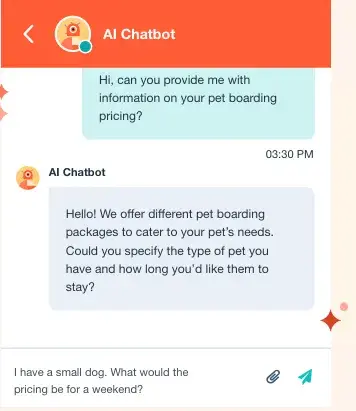
Pros
- Immediate responses: Available 24/7.
- Handles multiple queries at once: One AI chatbot can talk to many customers at once.
- Cost-effective: Chatbots can reduce the need for a large support staff.
Cons
- Limited nuance: AI chatbots won’t have the same understanding of complexity and nuance as a real person, such as dealing with humor or sarcasm.
- Impersonal: AI chatbots lack human touch and empathy. (At least for now …)
- Potential for frustration: It can be very dissatisfying when an AI chatbot or assistant can’t help with your issue. Think about all the times you’ve been stuck on the phone smashing the # button over and over, trying to get in touch with a real person.
9. Interactive Virtual Assistant
Chatbots are no longer novelties that customer service teams use to show off their technological prowess. Now, they're integral pieces of support strategies as they act more like interactive virtual assistants than simple, question-and-answer bots. Today's chatbots are powered by innovative AI technology that interprets customer needs and can walk people through step-by-step solutions.

The image above shows a perfect example of how useful today's virtual assistants can be. In this situation, the customer is learning how to use their new car — a product that typically offers a lot of unique features and an extensive operator's manual. To help new users navigate the car's basic features, this brand offers an augmented reality tour hosted by a virtual assistant. The user simply has to scroll their camera over different parts of the car and the chatbot will tell them everything they need to know.
Interactive features like this show that you're investing in more than just product development. You're thinking about how you'll support customers and what services you can adopt that will make their lives easier. Customers pay attention to this type of customer service and it can often be a reason why many will return to your business.
10. Integrated Customer Service
Integrated service encompasses all the little actions you take to eliminate customer pain points. Instead of waiting for customers to reach out with problems for you to solve, integrated service aims to proactively address customer issues. I like to think of integrated customer service as a company-wide, strategic initiative to optimize all business processes toward solving customer needs.
That can mean designing products that better address a need or implementing automated customer service tools to streamline support and reduce customer pain points associated with increased demand.
What Do Customers Want From a Typical Customer Service Situation?
As a former HubSpot Support rep, I’ve got a few tips for you on how to give customers the most out of each customer service interaction.
Listen actively.
My customer service motto has always been this: Listen with the intent to understand, not to respond. Listening actively means paying close attention to what the customer is saying, and when you finally do respond, make it clear that you know what it is they need.
I don’t think there is anything quite as frustrating as when a customer service rep gives you a boilerplate response that doesn’t actually address your issue at all, so don’t be that guy. Listen closely to the customer, understand their needs, and don’t be afraid to ask follow up questions and paraphrase to ensure you’re both on the same page.
Avoid making customers repeat information.
As a customer, I find that having to repeat information is very frustrating. It makes me feel like the company or representative wasn’t listening to me properly in the first place. I recommend using a CRM or ticketing system that can save a history of all customer interactions directly on each contact record. That way, you have access to a customer’s complete interaction history the moment they open a ticket.
Be pleasant and empathetic.
I’ve found that it’s crucial to convey a warm and inviting tone in all customer interactions. Over email, it can be a little trickier, so I like to use phrases like “I’d be happy to help with that,” or “I hope you are having a wonderful day,” in order to quell any possibilities of unintentional coldness.
Underpinning all successful customer service interactions is empathy. You have to genuinely want to help the person on the other end of the line, and there really is no faking it.
When I worked with HubSpot's support team, there were plenty of challenging cases where I had to give customers bad news. However, a little empathy makes all the difference. For example, I would say something like:
“I know this is frustrating, but unfortunately, we are working through an issue with the product. I sincerely apologize, and I’ll keep you updated as soon as I know more.”
Acknowledging the customer’s feelings in a tough situation makes all the difference. The customer wants their needs to be met, and that includes being made to feel seen, heard, and respected.
Be responsive.
Customers want their issues to be solved quickly, and who can blame them? When it’s my turn to be the customer, I want to reach a resolution as quickly as possible.
As a customer service rep, my ideal scenario is to solve the issue immediately upon my initial reply. However, that’s not always possible. I might need to ask follow-up questions or reach out to other teams for assistance. In either case, I always set clear expectations with the customer regarding the progress of the case and expected resolution time.
Being responsive to customer needs requires effective prioritization, time management, the right tools, and a little elbow grease. As a former HubSpot support rep, my best advice is to dive head-on into every case without hesitation. It’s easy to avoid responding to tough issues, but trust me — the best thing you can do is keep the customer in the loop and respond quickly, even if it's just to let them know you are still working on it.
What Customers Want
- Simple Solutions
- Personalization
- Value
- Transparency
- Accessibility
Each customer has their own unique needs, but there are a few that are universal.
1. Simple Solutions
Customers don’t need to know the complex ins and outs of your product (unless they’re into that); they just need it to work. Time is money, and everyone wants more of both. I don’t think it’s a good business move to give your customers money, but you can give them time by providing simple solutions that just work.
2. Personalization
Nobody likes feeling like just another number on a spreadsheet. I’ve found that leveling with customers and treating them as individuals goes a long way. You can use marketing tools to ensure you always address customers by name in communications and keep track of their preferences. However, the overarching goal should be to tailor the customer experience to their needs.
3. Value
Customers want to get their money’s worth, plain and simple. You might have the best product in the world, but it doesn’t have value if most customers can’t afford it. You can maximize value through performance or focus more on offering an affordable product. Either way, the customer demands some bang for their buck.
4. Transparency
I’ve found that the best way to build trust with customers is through transparency. No one wants to feel like they are being taken advantage of by shady tactics or hidden fees. Be transparent about as much as you can, from your pricing to what your product or service can or can’t do.
5. Accessibility
Customers need to be able to access you easily when they need help. These days, anything less than omni-channel service and support is not enough. If I’m unresponsive when my customers need me most, I can rest assured they will find someone else who is more than happy to pick up the phone.
Understanding Customer Needs and Expectations
Understanding customer needs is like going to the gym — you can’t just go once and expect results. It takes considerable effort, but it’s worth the sweat. You have to orient your entire culture around the customer and their needs. You’ve got to become customer-obsessed.
Once you’ve got a grasp on customer needs, you can go above and beyond and aim for customer delight. So keep listening, keep adapting, and keep your customers’ needs at the heart of everything you do. Trust me, they’ll notice.
Editor's note: This post was originally published in September 2020 and has been updated for comprehensiveness.
Customer Support

